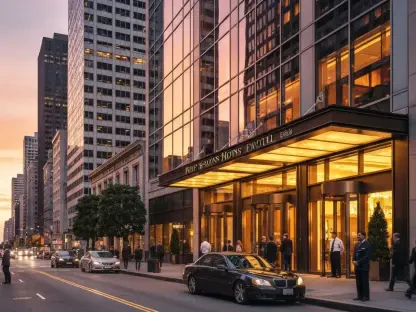In the aftermath of the pandemic, the U.S. hotel market has staged an impressive recovery, with RevPAR, a critical industry metric, rebounding to near pre-2020 levels. CoStar reported a RevPAR increase of 1.8% last year, nudging it to $99.94, and CBRE projects an additional growth of 2% by 2027. This upward trend is largely fueled by international tourism, group demand, and an uptick in business travel, signaling a positive trajectory. Yet, looming over these positive signs is a formidable threat: the escalation of property insurance costs. This hidden danger is significant enough to challenge the profitability and feasibility of hotel deals, posing a potential hurdle for continued growth in the sector.
Dynamics Driving Insurance Cost Increases
Surge in Premiums and Its Impact
Over the past 12 to 18 months, property insurance premiums have surged, presenting a major challenge for hotel underwriting and investment. Ryan Bosch from Arriba Capital highlights a typical rise of 5% to 15% for most hotels, with high-risk areas experiencing increases between 25% and 50%. These inflated premiums have transformed insurance costs from a mere detail into a crucial factor in hotel underwriting models. As they directly influence the Debt Service Coverage Ratio (DSCR), higher insurance costs could push refinancing efforts below essential debt thresholds, significantly affecting financial strategies.
This marked rise in premiums is attributed to several factors, including frequent weather-related events, higher building costs, and reduced capacity among insurance carriers. The effects are noticeable as more financial institutions scrutinize insurance packages more closely, leading to elevated reserves and demanding greater transparency. This cautious approach forces hotel owners to contribute more funds to close deals. The complexity of the situation further intensifies in high-risk locales, where securing affordable insurance becomes a key barrier to maintaining profitability and investment success.
Geographical and Sector-Specific Challenges
Specific geographical areas and certain property features bear the brunt of these rising costs more than others. Coastal regions, notably Florida and parts of California, face significant challenges due to their high-risk profiles, requiring specialized builders’ risk coverage for new projects. These areas grapple with a severe lack of carrier appetite for high-catastrophe zones, often necessitating multiple carriers for comprehensive coverage, thus complicating both cost and logistics. Recent wildfire losses in California, estimated at $75 billion, underscore severe hurdles for hotels seeking affordable insurance in these locales.
Florida’s situation illustrates the precariousness of securing insurance for vulnerable assets, particularly as state-run insurers like Citizens opt out of covering high-risk properties, relegating owners to higher premium surplus lines carriers. These carriers command premium prices owing to the elevated risk and present challenging claim disputes. Additionally, other areas such as the Carolinas, Gulf regions, Texas, and parts of the Midwest increasingly experience intense convective storms, prompting higher premiums as insurance companies adjust to mitigate increased risks, further burdening these regions with rising costs.
Underwriting Adjustments and Industry Responses
Tightened Underwriting Practices
To counter rising losses, insurance companies have tightened underwriting policies significantly, particularly focusing on risk-laden areas like liquor liability, human trafficking exposure, and properties with children’s programs. This conservative stance on underwriting mirrors a broader industry trend of heightened caution, directly impacting lending sentiments. Such changes also affect hotels with unblemished claims histories, which face challenges in this risk-averse insurance landscape despite maintaining a clean track record, as broader market dynamics drive up costs.
The cautious stance of insurers, coupled with stringent new policies, underscores the critical need for hoteliers to engage with new realities, adopting strategies that might help them mitigate heightened scrutiny and premium rates. Staying informed about new requirements and anticipating underwriting demands are key strategies that industry participants are adopting. Cooperation with lenders and insurers to facilitate better coverage terms while reducing exposure to the sprawling financial impacts of these elevated premiums is crucial for sustaining profitability.
Adapting to Market Challenges
The hotel industry’s landscape is evolving under the strain of rising insurance costs, prompting significant recalibrations among industry players. As insurance emerges as a pivotal disruptor, owners and investors are considering innovative paths to navigate these challenges. Focus has shifted to devising strategic partnerships with insurers and diversifying risk profiles to secure more stable coverage. Insights from leading industry figures emphasize the importance of adapting to these dynamics, combining proactive risk management with a thoughtful approach to integrating insurance solutions for future-proofing operations.
To tackle these challenges, hotel owners are exploring enhanced risk mitigation strategies and reevaluating asset portfolios to assess vulnerabilities. Collaborating closely with brokers and insurers to refine coverage options is becoming integral to sustaining financial health against rising premiums. Furthermore, hotels are increasingly investing in infrastructure improvements and climate resilience measures to counteract the long-term impacts of unpredictable risks and maintain a robust market position. These strategic adaptations reflect a resilient industry poised to survive and thrive amid turbulence.
Navigating the Complex Insurance Landscape
Following the COVID-19 pandemic, the U.S. hotel market has demonstrated a remarkable recovery. RevPAR (Revenue Per Available Room), a vital industry metric, has bounced back to almost pre-2020 figures. Last year, CoStar reported an increase in RevPAR by 1.8%, bringing it to $99.94. Looking forward, CBRE anticipates a further growth of 2% by 2027. This positive momentum is largely driven by a resurgence in international tourism, increased group demand, and a rise in business travel, outlining a favorable outlook for the future of the industry. However, despite these optimistic signals, there is a significant challenge that could impede progress: the soaring costs of property insurance. These costs represent a substantial risk that threatens the profitability and feasibility of hotel transactions. If not adequately managed, rising insurance expenses might become a substantial obstacle, hindering sustained growth and financial stability in the hotel sector in the coming years.









